Define an indicator random variable Xkl = I {
h(k) = h(l) } such that key k ≠ key l .
Xkl represents the possible values of a collision
occurrence (i.e. key k and l both hashed to same slot in the
array). Since simple uniform hashing is used, the probability of a
key x that hashed to a location in a table is  .
.
The probability that both keys h(k) and h(l) represent the same slot S (i.e. the probability for collision) is Pr { h(k) = h(l) }.
Pr { h(k) = h(l)} = 
Therefore, the expectation value of both keys representing the same slot in the array is
E  =
= 
Now, the total expected number of collisions is E .
.
E =
=  E
E 
Since, collisions are detected for  combinations of key pairs (k , l) such that k ≠
l,
combinations of key pairs (k , l) such that k ≠
l,
 E
E  =
= 
= 
= 
Hence, the expected number of collisions is 
Inserting Keys into Hash Table with Collisions Resolved by Chaining
Chaining is one of the collision resolution techniques. In this
technique, an index or slot  of a hash
table
of a hash
table  contains a
linked list of elements with the same index
contains a
linked list of elements with the same index  which is
calculated by the hash function.
which is
calculated by the hash function.
The following procedure shows an implementation of a hash table
 such that
each key
such that
each key  of a
universe
of a
universe  maps to an
index or slot in the hash table. Here, the number of slots in the
table is 9. So the range of the index of the table is from 0 to 8.
And the hash function is
maps to an
index or slot in the hash table. Here, the number of slots in the
table is 9. So the range of the index of the table is from 0 to 8.
And the hash function is  . Therefore
a slot
. Therefore
a slot  is occupied
by a value with key
is occupied
by a value with key  . The hash
table does not allow the duplicate values.
. The hash
table does not allow the duplicate values.
Insert the key 5 into the hash table  :
:
Find the index of the table to insert the key 5 using the hash function,


Therefore, the index to hold the key 5 is 5.
Search about the key 5 in the liked list of keys at the index 5 in the hash table.
Here, the key 5 is not found in the hash table.
Insert the key 5 as head of the list at the index 5 in the table.
After inserting the key 5, the hash table  is as
below.
is as
below.
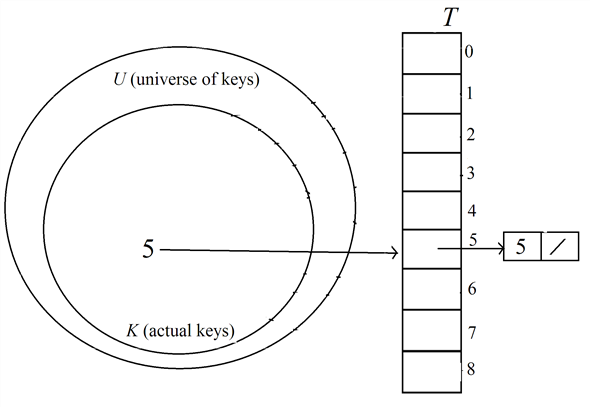
Insert the key 28 into the hash table  :
:
Find the index of the table to insert the key 28 using the hash function,


Therefore, the index to hold the key 28 is 1.
Search about the key 28 in the liked list of keys at the index 1 in the hash table.
Here, the key 28 is not found in the hash table.
Insert the key 28 as head of the list at the index 1 in the table.
After inserting the key 28, the hash table  is as
below.
is as
below.
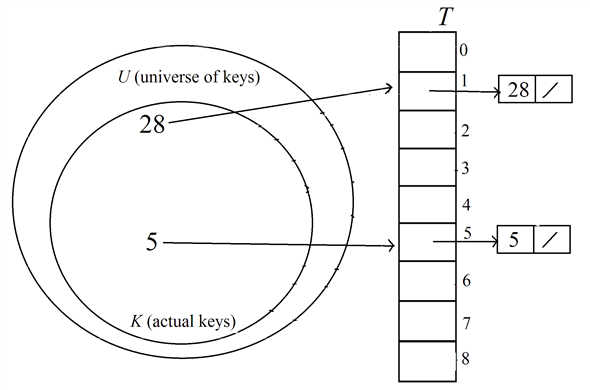
Insert the key 19 into the hash table  :
:
Find the index of the table to insert the key 19 using the hash function,


Therefore, the index to hold the key 19 is 1.
Search about the key 19 in the liked list of keys at the index 1 in the hash table.
Here, the key 19 is not found in the hash table.
Insert the key 19 as head of the list at the index 1 in the table.
After inserting the key 19, the hash table  is as
below.
is as
below.
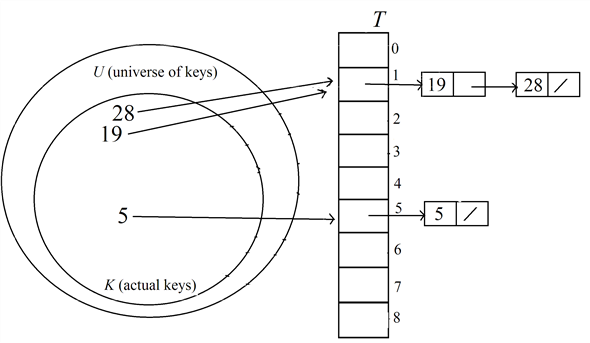
Insert the key 15 into the hash table  :
:
Find the index of the table to insert the key 15 using the hash function,


Therefore, the index to hold the key 15 is 6.
Search about the key 15 in the liked list of keys at the index 6 in the hash table.
Here, the key 15 is not found in the hash table.
Insert the key 15 as head of the list at the index 6 in the table.
After inserting the key 15, the hash table  is as
below.
is as
below.

Insert the key 20 into the hash table  :
:
Find the index of the table to insert the key 20 using the hash function,


Therefore, the index to hold the key 20 is 2.
Search about the key 20 in the liked list of keys at the index 2 in the hash table.
Here, the key 20 is not found in the hash table.
Insert the key 20 as head of the list at the index 2 in the table.
After inserting the key 20, the hash table  is as
below.
is as
below.
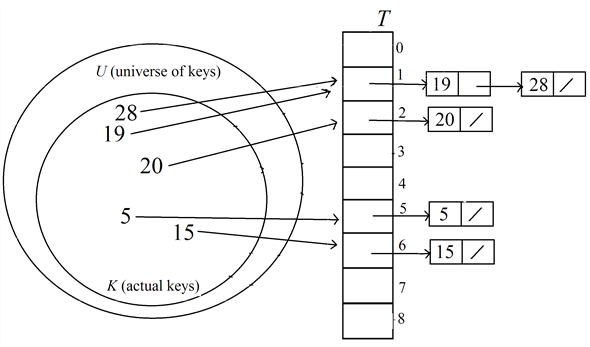
Insert the key 33 into the hash table  :
:
Find the index of the table to insert the key 33 using the hash function,


Therefore, the index to hold the key 33 is 6.
Search about the key 33 in the liked list of keys at the index 6 in the hash table.
Here, the key 33 is not found in the hash table.
Insert the key 33 as head of the list at the index 6 in the table.
After inserting the key 33, the hash table  is as
below.
is as
below.
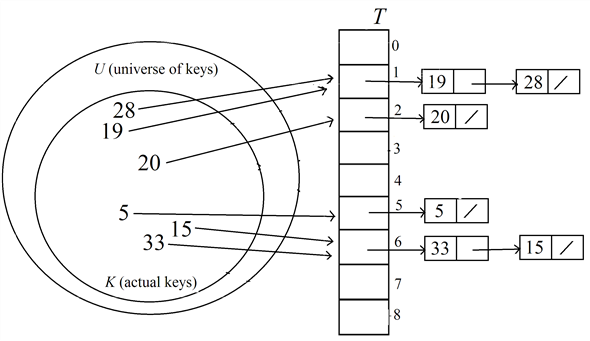
Insert the key 12 into the hash table  :
:
Find the index of the table to insert the key 12 using the hash function,


Therefore, the index to hold the key 12 is 3.
Search about the key 12 in the liked list of keys at the index 3 in the hash table.
Here, the key 12 is not found in the hash table.
Insert the key 12 as head of the list at the index 3 in the table.
After inserting the key 12, the hash table  is as
below.
is as
below.
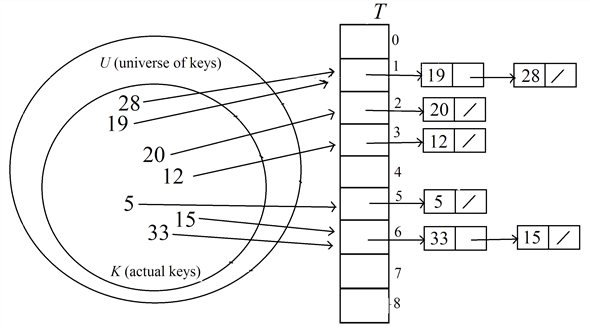
Insert the key 17 into the hash table  :
:
Find the index of the table to insert the key 17 using the hash function,


Therefore, the index to hold the key 17 is 8.
Search about the key 17 in the liked list of keys at the index 8 in the hash table.
Here, the key 17 is not found in the hash table.
Insert the key 17 as head of the list at the index 8 in the table.
After inserting the key 17, the hash table  is as
below.
is as
below.
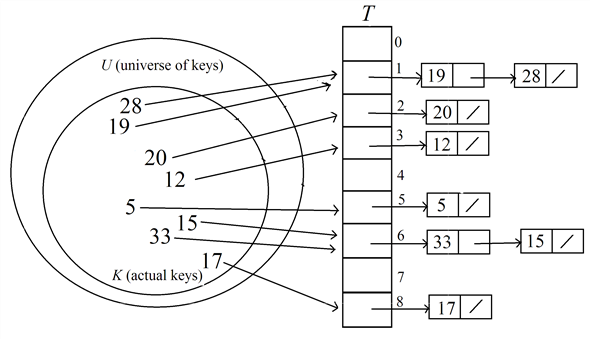
Insert the key 10 into the hash table  :
:
Find the index of the table to insert the key 10 using the hash function,


Therefore, the index to hold the key 10 is 1.
Search about the key 10 in the liked list of keys at the index 1 in the hash table.
Here, the key 10 is not found in the hash table.
Insert the key 10 as head of the list at the index 1 in the table.
After inserting the key 10, the hash table  is as
below.
is as
below.
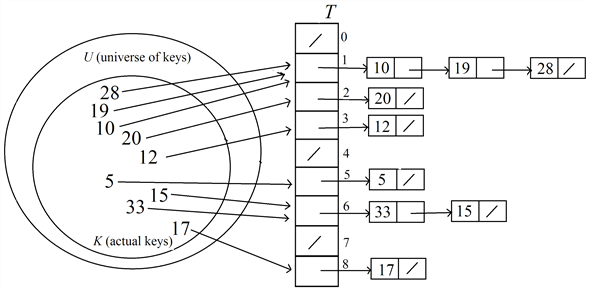
The slots with no elements are filled as NIL(/) in the
resultant hash table  .
.
When the hashing with chaining method is modified such that each list is maintained in sorting order, this modification effects the running time of successful searches, unsuccessful searches, insertions, and deletions as follows:
Running time effect on Successful search:
In changing scheme with unsorted lists, the complexity of
successful search is  where
where .
That is, time complexity of the successful search is proportional
to the length of the list. In the worst case, the whole list is
traversed to search an element. The length of the list is same,
even though list is sorted or unsorted. Thus the modification does
not affect the running time complexity of successful search.
.
That is, time complexity of the successful search is proportional
to the length of the list. In the worst case, the whole list is
traversed to search an element. The length of the list is same,
even though list is sorted or unsorted. Thus the modification does
not affect the running time complexity of successful search.
Therefore, running time complexity of successful search, in
chaining scheme with sorted lists, is still  .
.
Running time effect on Unsuccessful search:
In chaining scheme with unsorted lists, the complexity of
unsuccessful search is . in the
unsuccessful search, the running time of unsuccessful search is
proportional to the length of the list. Thus, in chaining scheme
with sorted list, the time complexity for unsuccessful search is
also
. in the
unsuccessful search, the running time of unsuccessful search is
proportional to the length of the list. Thus, in chaining scheme
with sorted list, the time complexity for unsuccessful search is
also . Hence, the
modification also does not affect the running time of unsuccessful
search.
. Hence, the
modification also does not affect the running time of unsuccessful
search.
Therefore, in chaining scheme with sorted list, running time
complexity of unsuccessful search is still  .
.
Running time effect on Deletion:
Before deleting an element from lists, it is required to find
(or search) that element in list. That is, the running time for
deletion is same as running time of searching time. Thus, the
running time complexity of deletion is . However,
the case of deletion an element is similar to successful search.
Therefore, the running time does not change with modified
scheme.
. However,
the case of deletion an element is similar to successful search.
Therefore, the running time does not change with modified
scheme.
Therefore, running time complexity of deletion in sorted list
is still  .
.
Running time effect on Insertion:
Since, in chaining scheme with unsorted lists, an element is
inserted at the head of the list, the time complexity of insertion
is .
But, in the modified scheme, before inserting a new element, a
proper place is required to be found (searched) in the sorted list.
Running time for searching appropriate place is similar to running
time for unsuccessful search. The running time complexity of
unsuccessful search in chaining scheme with sorted lists
is
.
But, in the modified scheme, before inserting a new element, a
proper place is required to be found (searched) in the sorted list.
Running time for searching appropriate place is similar to running
time for unsuccessful search. The running time complexity of
unsuccessful search in chaining scheme with sorted lists
is .
.
Thus, the running time complexity of insertion in modified
scheme is  .
.
Since, the modified scheme does not affect the running time of successful search, un successful search and deletion, except the insertion, the modified scheme does not improve the performance chaining scheme. Moreover, it increases the running time of insertion.
A hash table with m slot size is denoted by T which is having the capacity to store n keys from the set universe U.
Since the table is having m slots, the hash function
h maps the keys of universe U into the different
slots of hash table .
.
Proving that if keys are selected from U
with  , then there exist a subset of keys, having size
n , in U such that all
n keys hash to the same slot:
, then there exist a subset of keys, having size
n , in U such that all
n keys hash to the same slot:
• Consider the universe U of size greater than nm
(i.e. ) and a hash
table T of size m.
) and a hash
table T of size m.
• The set U contains the keys from 1, 2,…, ,… and each
key can be mapped to a slot into T.
,… and each
key can be mapped to a slot into T.
• Since hashing with chaining is using, if ,
,  keys can be
mapped into each slot of T.
keys can be
mapped into each slot of T.
• But, since , there
exist some sub sets of size
, there
exist some sub sets of size  keys in
U, such that all the keys of sub set can be mapped to same
slot. Also there exist some sub sets of size
keys in
U, such that all the keys of sub set can be mapped to same
slot. Also there exist some sub sets of size  keys in
U, such that all the keys can be mapped to same slot.
keys in
U, such that all the keys can be mapped to same slot.
• From the above, we can conclude that the set U has a
set of size at least  , such that
all the keys of the subset can be hash to same slot. That is, the
number of keys mapped to same slot will be at least n.
, such that
all the keys of the subset can be hash to same slot. That is, the
number of keys mapped to same slot will be at least n.
• Since the searching time for a key is proportional to number
of keys inserted into the slot, the worst case search time for
hashing with chaining will be  .
.
Hence if the n keys from the
universe U with  ,
are inserted into a hash table T of size
m , the minimum number of keys that can be
mapped into same slot is n and thus the
searching time for hashing with chaining will be
,
are inserted into a hash table T of size
m , the minimum number of keys that can be
mapped into same slot is n and thus the
searching time for hashing with chaining will be  .
.
Consider that n keys are hashed into a hash table of size m using chaining and the length of the each chain is known. Length of the longest chain is L.
To select a key uniformly at random means that each key in the hash table have equal probability to be selected.
The following procedure selects a key uniformly at random an returns in time O(L(1+m/n)).
• Repeat a loop until the procedure finds a non-empty bucket and return a key.
• Select a bucket b , randomly.(i.e. b= 0,1,…,m-1).
• The selected bucket may contain a chain of length between 0 to L.
• From the selected bucket b, randomly select a key k from the chain (i.e. k=1, 2, 3…L).
i)
The time required to retrieve an element and to return from a
chain of length L = 
ii)
Expected number of elements per bucket is = 
The probability for each element in the chain with length
 to
be selected =
to
be selected = 
= 
The probability for selecting and return any one of the elements
in the chain with length  =
= 
Therefore the time required to pick a key randomly is =

Hence, the total time taken by the procedure to select a key
uniformly at random =  +
+ 
= 
= 
=  Since,
Since,
 ;
;
 .
.




